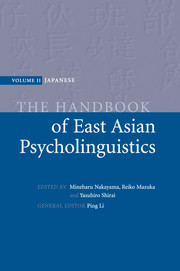Book contents
- Frontmatter
- Contents
- List of figures
- List of contributors
- In memory of Miwa Nishimura
- Preface
- Introduction
- Language acquisition
- 1 Ontogeny of language
- 2 Caregivers' speech
- 3 The intrinsic link between gesture and speech at the prelinguistic stage
- 4 Infant speech perception
- 5 Phonological acquisition
- 6 The mechanism of lexical development: implications from Japanese children's word learning
- 7 The acquisition of nouns and verbs in Japanese
- 8 The acquisition of verbal nouns
- 9 The acquisition of Japanese numeral classifiers
- 10 The acquisition of case markers
- 11 The acquisition of tense and aspect
- 12 On the origin of children's errors: the case of Japanese negation and direct passive
- 13 Binding Theory in UG and first-language acquisition of Japanese
- 14 The acquisition of the particles ne, yo, and no
- 15 The acquisition of linguistic politeness in Japanese
- 16 Children's narrative structures
- 17 Memory talk and testimony in children
- 18 Developmental dyslexia
- 19 Japanese Sign Language
- 20 The role of an innate acquisition device in second-language acquisition
- 21 Japanese, the grammar of reflexives, and second-language acquisition
- 22 Processes in L2 Japanese sentence production
- 23 The development of lexical competence among second-language readers
- 24 Reading in Japanese as a second language
- 25 Intrasentential code-switching in Japanese and English
- Part II Language processing
- References
- Name index
- Subject index
18 - Developmental dyslexia
from Language acquisition
Published online by Cambridge University Press: 05 June 2012
- Frontmatter
- Contents
- List of figures
- List of contributors
- In memory of Miwa Nishimura
- Preface
- Introduction
- Language acquisition
- 1 Ontogeny of language
- 2 Caregivers' speech
- 3 The intrinsic link between gesture and speech at the prelinguistic stage
- 4 Infant speech perception
- 5 Phonological acquisition
- 6 The mechanism of lexical development: implications from Japanese children's word learning
- 7 The acquisition of nouns and verbs in Japanese
- 8 The acquisition of verbal nouns
- 9 The acquisition of Japanese numeral classifiers
- 10 The acquisition of case markers
- 11 The acquisition of tense and aspect
- 12 On the origin of children's errors: the case of Japanese negation and direct passive
- 13 Binding Theory in UG and first-language acquisition of Japanese
- 14 The acquisition of the particles ne, yo, and no
- 15 The acquisition of linguistic politeness in Japanese
- 16 Children's narrative structures
- 17 Memory talk and testimony in children
- 18 Developmental dyslexia
- 19 Japanese Sign Language
- 20 The role of an innate acquisition device in second-language acquisition
- 21 Japanese, the grammar of reflexives, and second-language acquisition
- 22 Processes in L2 Japanese sentence production
- 23 The development of lexical competence among second-language readers
- 24 Reading in Japanese as a second language
- 25 Intrasentential code-switching in Japanese and English
- Part II Language processing
- References
- Name index
- Subject index
Summary
Research on developmental dyslexia seems to have been hampered because the very entity of dyslexia is elusive. A typical and traditional definition, “a profound reading difficulty which is not commensurate with the child's intelligence, and which occurs in spite of adequate schooling” (Stuart-Hamilton 1995: 35), should be taken as tentative. In this chapter, we consider what dyslexia looks like and what problems exist in Japan by discussing the two oft-asked questions concerning correlates of dyslexia and the interaction between dyslexia and script. Although studies on dyslexia in Japanese are surprisingly few compared with those in English, problems involving probable dyslexic children in Japanese are psychologically real and need to be discussed from a wider perspective.
Correlates of dyslexia
Frith (1999:192) defines dyslexia as “a neuro-developmental disorder with biological origin and behavioural signs which extend far beyond problems with written language.” Given this definition, we expect characteristic behavioral and neurological signs of dyslexia to emerge regardless of what language the child may speak if he/she is dyslexic. Indeed, research has shown a variety of correlates of dyslexia which may roughly be classified into five categories: phonological, visual, motoric, temporal processing, and environmental deficits (e.g. Harbib, 2000).
Phonological and phonology-related deficits
In the rubric of a phonological deficit, a wide range of phonological impairments has been identified including poor performance on phoneme segmentation and other tasks (e.g. Lyon, 1995). For example, English-speaking dyslexic children experience great difficulty segmenting cat into three phonemes.
- Type
- Chapter
- Information
- The Handbook of East Asian Psycholinguistics , pp. 130 - 136Publisher: Cambridge University PressPrint publication year: 2006



